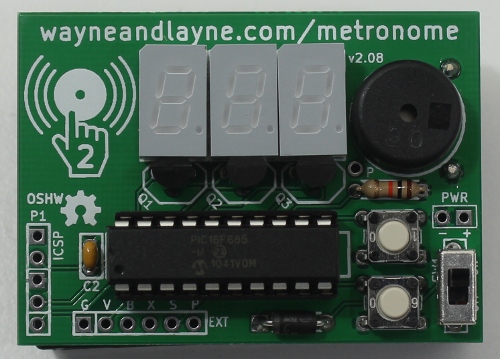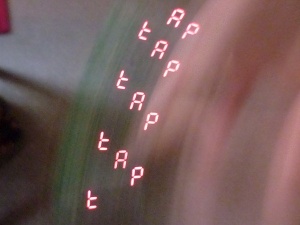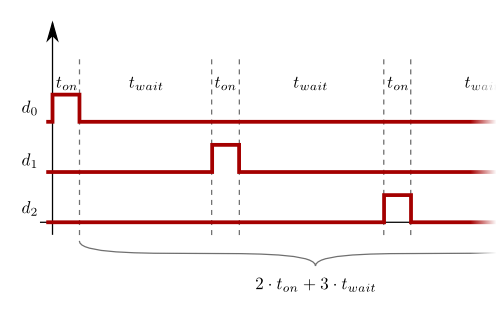Bluetooth Keyboard Module, Part 1
 Adam and Matthew (Wayne and Layne) went to the same college and shared a dorm room for the first two years before moving off campus. During the first year, we had a Gauntlet arcade cabinet in our dorm room that we modded pretty heavily. We completely redid the control panel, adding cup holders and a bunch more buttons. We put a linux PC and modern display inside and played classic video games on emulators. Combined with a custom game launcher Matthew wrote, it was a great hit, especially with the RAs. There’s nothing like keeping your door open after quiet hours because your RA is too wrapped up trying to beat the original Legend of Zelda.
Adam and Matthew (Wayne and Layne) went to the same college and shared a dorm room for the first two years before moving off campus. During the first year, we had a Gauntlet arcade cabinet in our dorm room that we modded pretty heavily. We completely redid the control panel, adding cup holders and a bunch more buttons. We put a linux PC and modern display inside and played classic video games on emulators. Combined with a custom game launcher Matthew wrote, it was a great hit, especially with the RAs. There’s nothing like keeping your door open after quiet hours because your RA is too wrapped up trying to beat the original Legend of Zelda.
 The original control panel had leaf-style switch contacts, meaning that two flexible pieces of metal would be pressed together when a button was pushed or joystick moved. This was sloppy and starting to wear out, so we designed a new control panel that would use microswitch buttons and joysticks. The new control panel worked like a charm, and gave us many hours of Tetris, Zelda, and Super Mario Brothers.
The original control panel had leaf-style switch contacts, meaning that two flexible pieces of metal would be pressed together when a button was pushed or joystick moved. This was sloppy and starting to wear out, so we designed a new control panel that would use microswitch buttons and joysticks. The new control panel worked like a charm, and gave us many hours of Tetris, Zelda, and Super Mario Brothers.
Unfortunately, like all good things, the Gauntlet arcade machine had to come to an end. We had to get rid of the cabinet and sold it to a collector for restoration. We saved the custom built control panel for a future project, with a vague idea of building it into a coffee table to play games on the television.
…months pass…
Weekly Link Dump for 2010-05-28
- Eye Pattern

In telecommunication, an eye pattern, also known as an eye diagram, is an oscilloscope display in which a digital data signal from a receiver is repetitively sampled and applied to the vertical input, while the data rate is used to trigger the horizontal sweep. It is so called because, for several types of coding, the pattern looks like a series of eyes between a pair of rails. - Russian Woodpecker
The Russian Woodpecker was a notorious Soviet signal that could be heard on the shortwave radio bands worldwide between July 1976 and December 1989. It sounded like a sharp, repetitive tapping noise, at 10 Hz, giving rise to the “Woodpecker” name. The random frequency hops disrupted legitimate broadcast, amateur radio, utility transmissions, and resulted in thousands of complaints by many countries worldwide. The signal was long believed to be that of an over-the-horizon radar (OTH) system. - Heron’s Fountain

Heron’s fountain is a hydraulic machine invented by the first century inventor, mathematician, and physicist Heron, also known as Hero of Alexandria. Heron studied the pressure of air and steam, described the first steam engine, and built toys that would spurt water, one of them known as Heron’s fountain. - Involuntary Park
Involuntary park is a neologism coined by science fiction author and environmentalist Bruce Sterling to describe previously inhabited areas that for environmental, economic or political reasons have, in Sterling’s words, “lost their value for technological instrumentalism” and been allowed to return to an overgrown, feral state. - Snake-in-the-Box
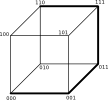
The snake-in-the-box problem in graph theory and computer science deals with finding a certain kind of path along the edges of a hypercube. This path starts at one corner and travels along the edges to as many corners as it can reach. After it gets to a new corner, the previous corner and all of its neighbors must be marked as unusable. The path should never travel to a corner after it has been marked unusable.
On-off keying eye diagram, a Creative Commons Attribution-ShareAlike 3.0 Unported image from Wikimedia Commons
Heron’s Fountain, a Creative Commons Attribution-ShareAlike 3.0 image from Wikimedia Commons
Welcome Maker Faire visitors!
After an amazing weekend at the 2010 Bay Area Maker Faire, Wayne and Layne are still getting caught up on sleep and other work. We’re collecting photos and videos from the event, so if you snapped a photo or recorded some video at our stand in the Maker Shed, we’d love to see them! You can email us at wayneandlayne at wayneandlayne dot com
We’ll have a “Maker Faire Highlights” post in a few days, complete with photos and video, and details on how to make the larger drum version of our Tactile Metronome. If anyone wants to get in contact with us, or purchase our metronome kit, go to the contact page or send us an email, and we’d be glad to talk to you!
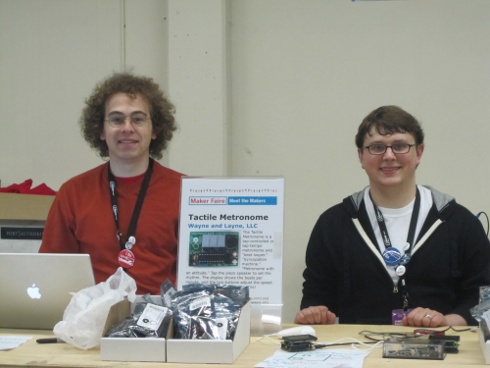
Wayne and Layne at the 2010 Bay Area Maker Faire
Weekly Link Dump for 2010-05-21
- North American video game crash of 1983

The North American video game crash of 1983 brought an abrupt end to what is considered the second generation of console video gaming in North America. It almost destroyed the then-fledgling industry and led to the bankruptcy of several companies producing home computers and video game consoles in North America. - Ghost Army (WWII)
The Ghost Army was a United States Army tactical deception unit during World War II, given a unique mission within the Army to impersonate other U.S. Army units in order to fool the enemy. They put on a traveling road show, using inflatable tanks, sound trucks, phony radio transmissions and even playacting. - Constellation Diagram

A constellation diagram is a representation of a signal modulated by a digital modulation scheme such as quadrature amplitude modulation or phase-shift keying. It displays the signal as a two-dimensional scatter diagram in the complex plane at symbol sampling instants. - The Curse of Dimensionality
The curse of dimensionality is the problem caused by the exponential increase in volume associated with adding extra dimensions to a (mathematical) space. The term was coined by Richard Bellman. - Cake Number

A cake number is the maximum number of pieces into which a 3-dimensional space can be cut with a given number of plane cuts. It is so called because one imagines each such slice cutting a cake. The sequence of cake numbers for n = 0, 1, 2, 3… is 1, 2, 4, 8, 15, 26…
Images:
Atari, a Creative Commons Attribution Share-Alike (2.0) image from farnea’s photostream
German chocolate cake, a Creative Commons Attribution Share-Alike (2.0) image from stuart_spivack’s photostream
Maker Faire is a two-day, family-friendly event that celebrates the Do-It-Yourself (DIY) mindset. It’s for creative, resourceful people of all ages and backgrounds who like to tinker and love to make things. So much to see, you will need 2 days to see it all!
We’re going to be at the Bay Area Maker Faire, May 22nd and 23rd. We’re going to be in the Maker Shed area, showing off our Tactile Metronome kit with a souped up mega-metronome. There will be kits available to purchase, and we’ll be doing workshops both Saturday and Sunday if you want to make your metronome with us.
Feel free to stop by, attach a face to our online handles, and chat microcontrollers and open source electronics. It’s sure to be a great time!
Hello world!
Welcome to the new Wayne and Layne website! We make open source hardware kits, meaning that all the schematics, PCB artwork, and source code are provided under open licenses. Our first kit, the Tactile Metronome, is an easy-to-make tap tempo metronome and beat looper, using all through-hole parts (easy to solder) with a professionally-made printed circuit board (PCB). It’s pretty fun to play with, too.
One of the distinguishing aspects of our kits is the clear and engaging explanations. One of the underlying principles of open source hardware is the ability for others to make modifications and release them. We foster this ability wholeheartedly, through our choice of licensing, file formats, and tools, and our down-to-earth explanations. We want to help anyone interested in this exciting field get the foundation they need.
We’ve got a bunch of new kits on the way, so check back soon for the details! Even better, you can follow our progress on RSS or Twitter using the links at the top of the page.
Wayne and Layne, LLC was founded by Adam Wolf (http://feelslikeburning.com/, @adamwwolf) and Matthew Beckler (http://www.mbeckler.org/, @mbeckler), two computer engineering graduates of the University of Minnesota. We love playing around with microcontrollers, and are continually amazed and inspired by the creativity and ingenuity of the maker community.





